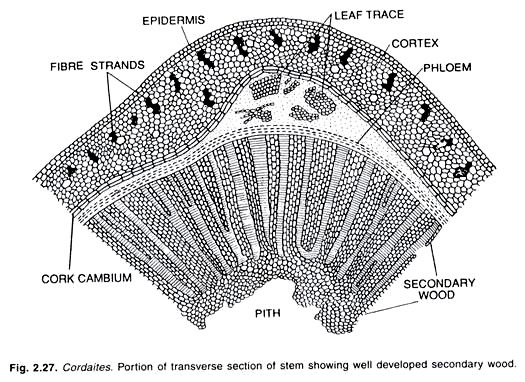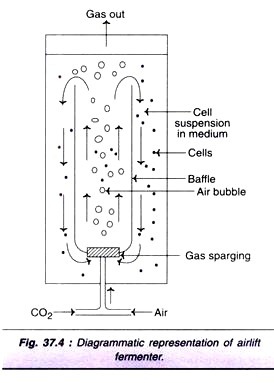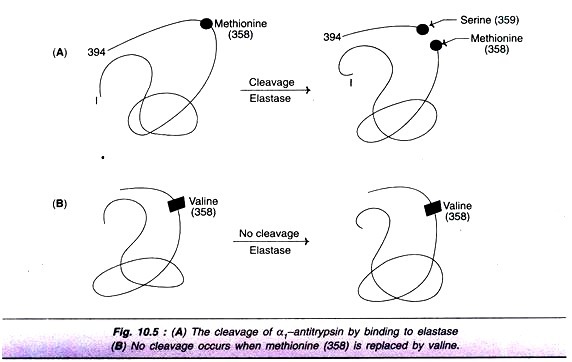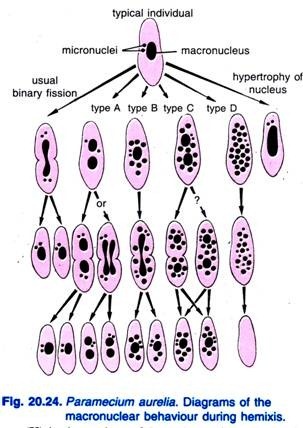Useful notes on Asexual Reproduction and Sexual Reproduction are described below:
There is a large diversity among animals. There are about 1.2 million types of animals.
The lower animals like protozoans, sponges and few coelenterates reproduce in one simple way while all the rest follow a different pattern of reproduction.
Based on whether there is participation of one organism or two in the process of reproduction, there are two types of reproduction.
When offspring is produced by a single parent with or without involvement of gamete formation, the type of reproduction is sexual. When two parents (of opposite sex) participate in the reproductive process and also involve fusion of male and female gametes, it is called sexual reproduction.
1. Asexual Reproduction:
In this type of reproduction neither the sex cells (nor gametes) are formed nor do they unite to form the zygote. Moreover, the participation of two organisms (male and female) is not required, only one organism reproduces. During asexual reproduction the body (somatic) cells divide, their nucleus divides either by mitosis or amitosis, therefore, such type of reproduction is also known as somatogenic or blastogenic reproduction. The asexual reproduction is commonly found in lower animals such as protozoans, sponges, coelenterates, certain worms and tunicates.
Principal forms of asexual reproduction are:
1. Binary fission
2. Multiple fission
3. Gemmulation
4. Budding
5. Fragmentation
6. Regeneration.
1. Binary Fission:
This is the simplest and most common method of asexual reproduction seen in unicellular organisms. This occurs under the favourable conditions of the environment. After the organism grown to its full size, the parent divides into two daughter cells which are genetically and morphologically similar. During this process, the nucleus divides into two, followed by the division of the cytoplasm.
According to the plane of division, following types of binary fission have been recognized in the organisms:
(a) Simple Binary Fission:
This type of binary fission occurs in the irregular-shaped organisms such as Amoeba in which the plane of division is difficult to ascertain (Fig. 3(A).1).
(b) Transverse Binary Fission:
If the plane of division is at right angle to the long axis of the animal, it is known as transverse binary fission as in Paramecium and Planaria (Fig. 3(A).2).
(c) Longitudinal Binary Fission:
In this type the plane of fission is parallel to the long axis, as in Euglena, Vorticella and in some corals (Fig. 3(A).3).
During binary fission the organelles of parent body either divide equally between two daughter individuals or one daughter individual retain them and other must develop new organelles.
2. Multiple Fission:
In multiple fissions the parent nucleus undergoes repeated divisions to form a large number of daughter nuclei. This is followed by the division of the cytoplasm into as many parts as there are nuclei, each part enclosing one nucleus. As a result a number of daughter cells are formed from a single parent cell at the same time. This process usually takes place under unfavorable environmental conditions. The multiple fissions occur in most algae, fungi and some protozoans, e.g., Amoeba, Plasmodium (malaria parasite) and Monocytes etc. (Fig. 3(A).4).
3. Gemmule in Sponges or Gemmulation:
Asexual reproduction occurs in sponges in various ways; the best known method is gemmulation. In freshwater sponges and a few marine sponges buds are formed within the parent body and are called gemmules. These are also called as endogenous buds or internal buds.
Gemmulation begins when a small group of cells (mostly archaeocytes) become ladden with reserve food granules and become isolated at the internal surface of a sponge. Bach one mass is covered over by a protective covering and is called as a geinmule. The gemmules are expelled from the adult sponge and this is a normal reproductive process in some marine sponges.
Sometimes, gemmule formation is a means to tide over unfavourable conditions. After degeneration of the parent sponge due to drought or temperature extremes, the gemmules are liberated and germinate to adult sponge.
The freshwater sponges under family spongillidae undergo a slight different form of gemmulation. Here the gemmules consist of mass of archaeocytes ladden with reserve food materials and, in addition, they are surrounded by protective membranes formed by the archaeocyte cells. The protective covering is generally reinforced by spicules, the skeletal materials of sponges. The gemmules of freshwater sponges allow a species to survive in unfavourable conditions. In cold regions, gemmulation occurs in winter and the inactive gemmules hibernate.
In warm regions, gemmulation occurs in summer and the gemmules are said to estivate. In next spring or autumn, as the case may be, when favourable conditions return, the gemmules germinate. Their archaeocytes emerge through an opening called micropyle. The various cellular types differentiate and a new sponge grows.
4. Budding in Hydra:
During the process of bud formation or budding an outgrowth or bud appears on the parent body. The bud may be unicellular as in some protozoans (suctoria) or multicellular as in certain lower metazoans like, Sycon (sponge), Hydra (Goelenterate), Planaria (flatworm), Syllis (annelid) etc.
One or more such buds may be produced from a single parent body. The bud, which is much smaller than the parent develops to its full size either after detachment from the parent or prior to detachment being attached to its parent body. Budding may be external or exogenous as in Hydra (Fig. 3(A).5) or internal or endogenous as in Acinata.
In Hydra the external bud develops as a conical outgrowth from the body wall by the accumulation of intcrsitial cells. The bud gradually develops tentacles around the mouth, coelenteron and later separated lion) its parent by developing a constriction at its base.
When the body of Hydra or Planaria is cut into several fragments, each fragment develops into a new individual. This process is known as fragmentation. Regeneration is a process by which organisms develop or regenerate their lost or worn-out parts. Regeneration is highly developed in lower animals like protozoans, sponges, coelenterates, planarians, echinoderms etc.
Advantages of Asexual Reproduction:
1. A large number of individuals are produced within a short period from a single parent.
2. The offspring’s are genetically identical to the parent.
3. It occurs only through simple mitotic division.
4. It helps in dispersal of young ones to far off places.
5. It also helps the animal to tide over unfavourable environmental conditions.
Disadvantages of Asexual Reproduction:
1. Continuous binary fission for several generations makes the daughter individuals genetically weak and requires rejuvenation.
2. Animals produced by asexual reproduction are generally less adaptable to changing environmental conditions.
3. Since the genetic constitution of the daughter individuals is similar to the parent there is no genetic variation in the offspring’s and hence does not contribute to speciation.
2. Sexual Reproduction:
Sexual reproduction is commonly found in the complex, multicellular organisms. It involves the union of male and female sex cells or gametes to form the zygote which grow into a new individual. Two different sexes (male and female) take part in the process. The testes in male produce male gametes or sperms and the ovaries in female produce female gametes or ova.
Both these sex organs may be present in the same body. Such animals are known as bisexual or hermaphrodite animals, e.g. earthworm. Formation of sperms and ova involves meiosis or reduction division during which haploid gametes are formed from the diploid cells. Gametes vary in shapes and sizes in different animals.
Fusion of male and female gamete is known as fertilization. During fertilization a haploid (n), motile male gamete or sperm fuses with a non- motile, haploid (n) female gamete or ovum to form a diploid (2n) zygote which gives rise to a new individual (Fig. 3(A).6).
Therefore, the fusion of gametes maintains the diploid chromosome number of the organism. The fertilization may occur outside the body (external fertilization) as in frog or inside the body (internal fertilization) as in man.
Advantages of Sexual Reproduction:
1. The offspring’s produced due to sexual reproduction adapt themselves successfully to the changing environmental conditions.
2. Formation of gametes by meiosis and their fusion during fertilization produce reshuffling of genes and variation in the offspring’s. Variations in the offspring’s help them in natural selection and evolution.
Disadvantages of Sexual Reproduction:
Since two parents of opposite sexes are needed i.e., biparental reproduction (except hermaphrodite forms) it is not as easy or as frequent as asexual or uniparental reproduction.





